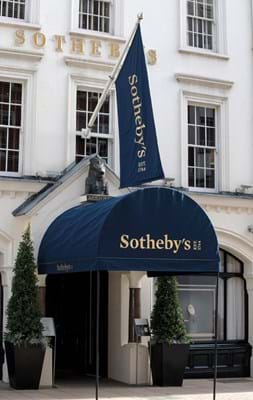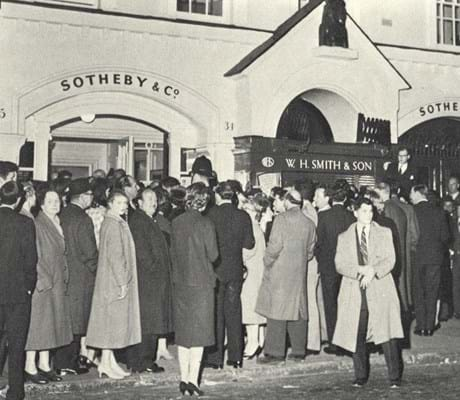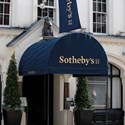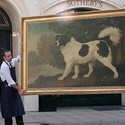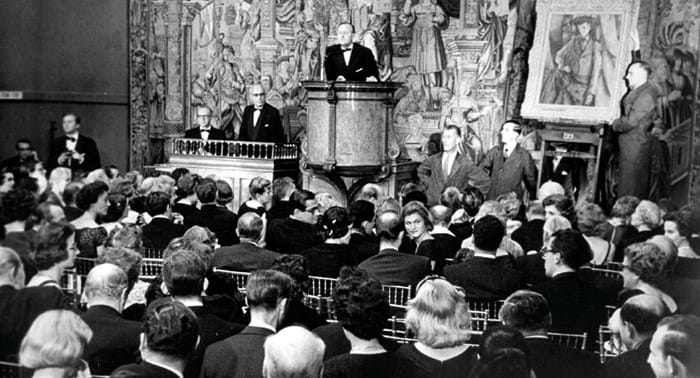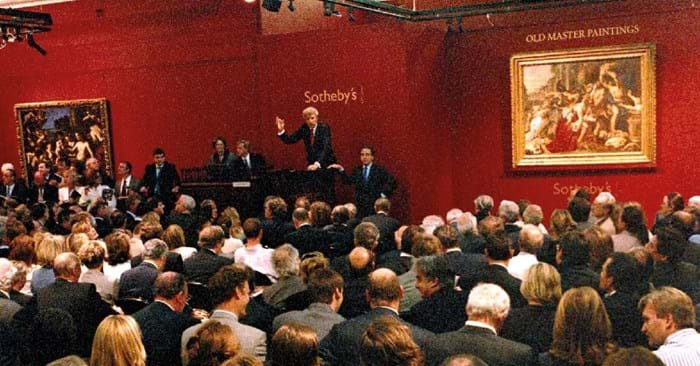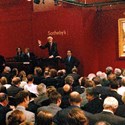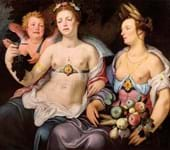Today, Sotheby’s operations in London are synonymous with 34-35 New Bond Street (commonly referred to as just Bond Street) – the prestigious Mayfair address to which the company moved 100 years ago.
A century on, it remains the auction house’s primary European headquarters and one of its two flagship global premises.
The other is an office on York Avenue in New York, although from the outside that 10-storey glass atrium could hardly look more different to the Bond Street building with its Regency frontage.
On the inside too, the Bond Street premises stands in stark contrast to the vogue for open-planned offices with its inner ‘rabbit warren’ of corridors and meeting rooms lying behind the ‘public’ areas. These include the partitioned exhibition spaces which can be opened up into the fully-sized saleroom.
The site remains one of the company’s most important assets – not just for its location in one of London’s prime pieces of real estate but also for the distinctive character and sense of history that it retains. These walls have seen art market history – not to mention the occasional moment of scandal.
Plotting a history
Before Sotheby’s move to Bond Street, the buildings had been through various incarnations.
They had hosted the galleries of prolific French artist Gustave Doré (1832- 83), been used as a parfumier’s shop and once housed a pub called the Black Horse. The wine cellars were later used for storing pictures.
The company was already over 170 years old by the time it moved to Bond Street from its previous saleroom in Wellington Street, just off the Strand.
Sotheby’s dates back to 1744 when it was founded by the bookseller Samuel Baker, with the firm later taking its name from the family of Baker’s nephew, John Sotheby, who continued to be involved in the auction house for more than 80 years.
The move to Bond Street was arguably the most significant single moment in the company’s history. It led to monumental changes, effectively giving the firm access to a new market as it expanded its main focus away from books and towards other areas including pictures and works of art.
The timing could hardly have worked out better, as Sotheby’s became well positioned to exploit the collections of British country houses which were being broken up after the First World War.
Gala sales
While Sotheby’s continued to trade during the Second World War, despite turning its basement into an air-raid shelter, a new chapter began in the late 1950s when company chairman Peter Wilson (who had begun as a trainee in the furniture department) reinstated evening sales for the first time since the 18th century.
The first was the landmark sale of the Goldschmidt collection of seven Impressionist paintings in October 1958. It was a black-tie event which generated huge publicity with the likes of Kirk Douglas, Anthony Quinn and Lady Churchill in the audience at one of the most famous nights ever staged in Bond Street.
The seven works generated £782,000, an unprecedented amount for an art auction, with the individual record for a painting broken three times in 20 minutes. In the process, the Impressionist market rose to a wholly new level.
With two New York dealers battling it out for the sale’s top lot, Paul Cézanne’s Garçon au Gilet Rouge, as the bidding reached a mammoth £220,000, auctioneer Peter Wilson quipped: “What, will no-one offer any more?”
The Goldschmidt sale was the first of many seminal evening sales in Bond Street which continue to this day. Since 2000, the saleroom has witnessed record prices for the likes of Rubens, Raphael and Turner – not a bad line-up by anyone’s standards.
As with its great rivals Christie’s, the firm places big weight on its heritage and its history has enabled it to build a brand that few businesses can match. Despite the rise of the internet and overseas expansion, the bricks and mortar on Bond Street clearly remain at its core.
In numbers
£618,000 Sotheby’s sales turnover in 1921 as it recovered from the First World War
£2.87bn Sotheby’s global auction sales figure for 2016
Five landmark sales at Sotheby's
1. 1928
Original manuscript of Alice’s Adventures Under Ground, given by Lewis Carroll to Alice Liddell. It sold to an American dealer, Dr Rosenbach.
Price: £15,400
Approx price in today’s money: £850,000
2. 1958
Paul Cézanne’s Garcon au Gilet Rouge, part of the landmark sale of paintings owned by Jakob Goldschmidt. At the auction it was knocked down to George Keller of New York’s Carstairs Gallery, who purchased it for collector Paul Mellon. The price was seven times more than any painting had ever achieved in Britain.
Price: £220,000
Approx price in today’s money: £4.8m
3. 1983
The Gospels of Henry the Lion – a 12th century illuminated manuscript, commissioned by Henry the Lion, Duke of Saxony, for Brunswick Cathedral. The price established a new high for a work of art at auction. It was eventually returned to Germany after funds were raised by German authorities and private donors.
Price: £8.14m (including premium)
Approx price in today’s money: £26m
4. 2002
Sir Peter Paul Rubens’ The Massacre of the Innocents, a masterpiece that still holds the record for an Old Master at auction and, at the time, was the highest auction price ever achieved in the UK. It sold in the room to the Mayfair book dealer Sam Fogg who was bidding for Canadian media baron David Thomson. It is now in the Art Museum of Ontario.
Price: £45m
Approx price in today’s money: £67m
5. 2010
Alberto Giacometti’s L’Homme qui Marche I set an auction record for any sculpture after it was consigned to Sotheby’s from the Dresdner Bank in Germany. The bronze was reportedly bought by Lily Safra, widow of the banker Edmond Safra.
Price: £58m
Approx price in today’s money: £69m
*Prices in today’s money are calculated using percentage increases in the RPI.


